If you see Disk Management could not start Virtual Disk Service & Disk Management is stuck at or not connecting to VDS, then this post will be able to help you.
Disk management is an essential tool that manages storage devices on Windows. It needs to connect to the Virtual Disk Service for the smooth working of your computer. However, there are instances when Disk Management fails to connect to the Virtual Disk Service, causing inconvenience while using the computer. In this guide, we explain to you the possible reasons why Disk Management is not connecting to Virtual Disk Service and different ways to fix it.
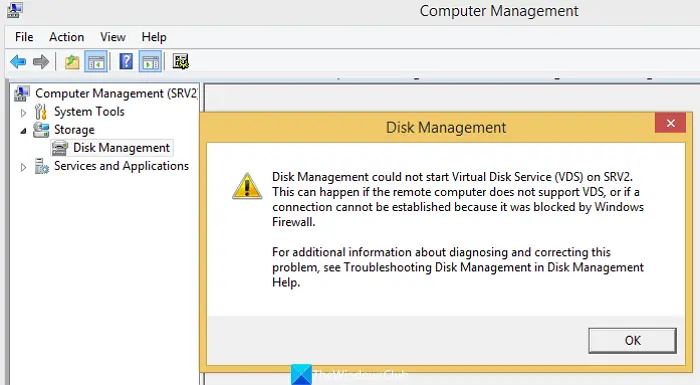
Why is Disk Management not connecting to Virtual Disk Service?
Generally, when we have issues with Disk Management not connecting to Virtual Disk Service, we see the following message.
Disk Management could not start Virtual Disk Service (VDS) on SRV2. This can happen if the remote computer does not support VDS, or if a connection cannot be established because it was blocked by Windows Firewall.
For additional information about diagnosing and correcting this problem, see Troubleshooting Disk Management in Disk Management Help.
The major potential causes for this issue are:
- Firewall or antivirus blocking the connection: The firewall on your computer or the antivirus might be interfering with the connection and preventing them from establishing a connection.
- Virtual Disk Service is not running: The Virtual Disk Service on your computer might not be running or responding to the request of Disk Management and making it hard to establish a connection between them.
- Corrupted System files: If there are any instances of corrupted system files, it may hinder many services and programs as they are intended. This could result in Disk Management not connecting to Virtual Disk Service error.
- Hardware issues: If there are any issues with the hardware of your computer and its cables, you might see the error.
Fix Disk Management stuck at or not connecting to Virtual Disk Service
If you are facing issues with Disk Management and its connection with the Virtual Disk Service, you can use the following methods to fix the issues easily.
- Temporarily disable Windows Defender
- Disable third-party Antivirus
- Manually enable Virtual Disk Service
- Run SFC and DISM Scans
- Allow Remote Volume Management through the Firewall
Let’s get into the details of each method and fix the issue.
Disk Management could not start Virtual Disk Service
1] Temporarily disable Windows Defender
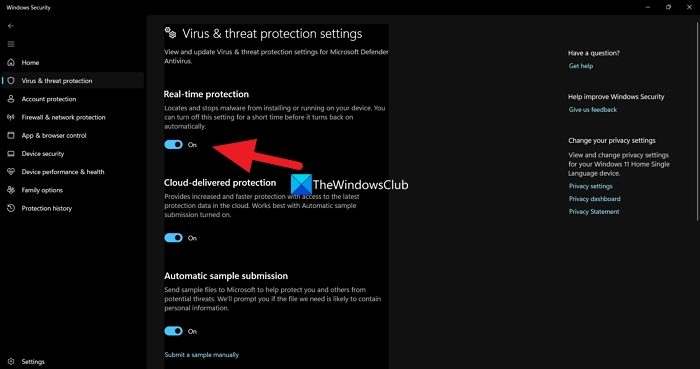
Windows Defender and its security settings might be interfering with Disk Management and its connectivity to the Virtual Disk service. You need to disable Windows Defender and see if it helps in fixing the issue.
To disable Windows Defender,
- Search Windows Security in the Start menu and open it
- Click on Virus & threat protection in the Windows Security app
- Click on Manage settings under Virus & threat protection settings
- Toggle the button off under Real-time protection and accept the prompt.
It is not recommended to turn off Windows Defender all the time as it may put the security of your computer at risk.
2] Disable third-party Antivirus
If you have a third-party antivirus program installed on your computer, it is better to disable it for the time being and see if it works. Third-party antivirus programs have a history of over-protecting nature which hinder most of the tasks we do.
3] Manually enable Virtual Disk Service
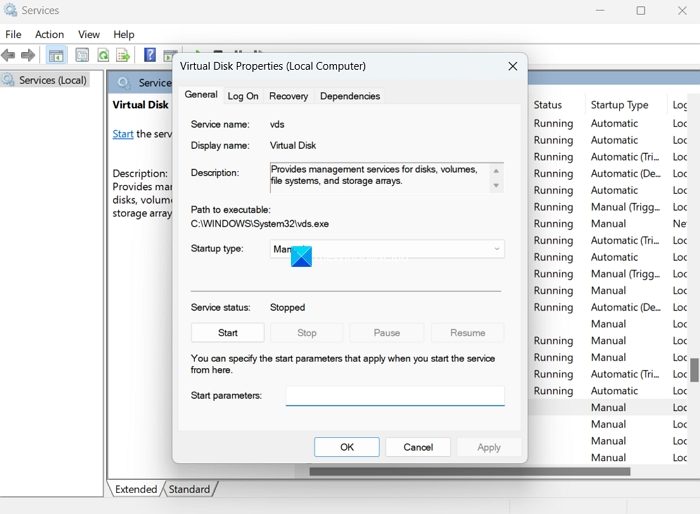
Another way to fix the Disk Management not connecting to the Virtual Disk service is by manually enabling the Virtual Disk service. You can do it in the Services app.
To enable Virtual Disk Service:
- Click on the Start menu and search for Services and open the Services app.
- You will see a long list of services in the Services app. Scroll down and find Virtual Disk.
- Double-click on Virtual Disk and click on Start under the Service status.
- You can also set the Startup type to Automatic.
- Click Apply and then OK to save the changes.
Fix: Diskpart Virtual Disk Service Error
4] Run SFC and DISM Scans
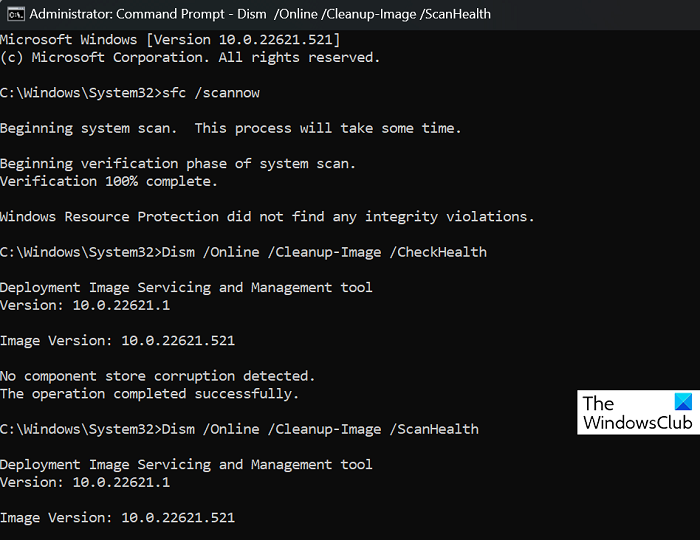
If the error is caused by corrupted or missing system files, you can fix them by running SFC and DISM scans. They automatically find the missing or corrupted files and replace them with the new thereby fixing the issues.
- Click on the Windows key and search for Command Prompt.
- Click on Run as Administrator.
- Type the following commands one by one and hit Enter:
For SFC: sfc/scannow
For DISM: DISM /Online /Cleanup-Image /CheckHealth DISM /Online /Cleanup-Image /ScanHealth DISM /Online /Cleanup-Image /RestoreHealth
- Restart your device once done and check if the error is fixed.
5] Allow Remote Volume Management through the Firewall
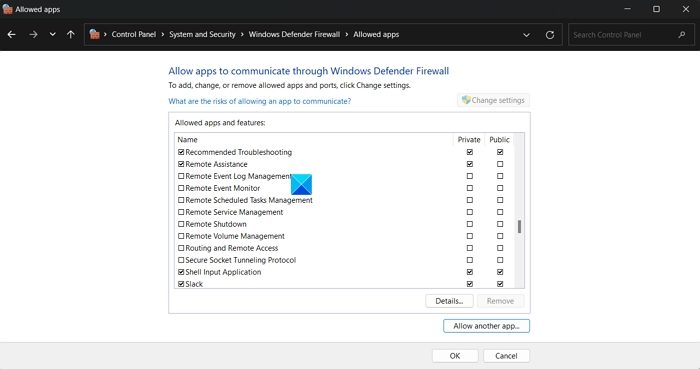
Remote Volume Management is necessary for Disk Management to connect with the Virtual Disk service. You need to make sure it is not blocked by Firewall and allow it through the firewall.
To allow Remote Volume Management through Firewall:
- Click on the Start menu and search for Windows Defender Firewall and open it.
- Click on Allow an app or feature through Windows Defender Firewall on the left side panel.
- Click on Change settings
- Scroll down through the Allowed apps and features. Find Remote Volume Management and check the boxes beside it.
- Click OK to save changes.
These are the different methods using which you can fix when you see the error Disk Management not connecting with Virtual Disk service on your computer.
Read: Disk Management not working, loading or responding
How do I fix Disk Management stuck on connecting to Virtual Disk Service?
When Disk Management is stuck on connecting to the virtual disk service, you need to make sure the cables and hardware are properly connected, check if the Virtual Disk service is properly running, and see if the firewall or antivirus is not blocking the connection.
Can I stop Virtual Disk Service?
Yes, you can stop the Virtual Disk service in the Services app on your Windows computer. Open the Services app, find Virtual Disk, and double-click on it. Click on Stop under Service status. Then, click Apply and Ok to save the changes.
Related read: Disk Management console view is not up-to-date in Windows 11/10